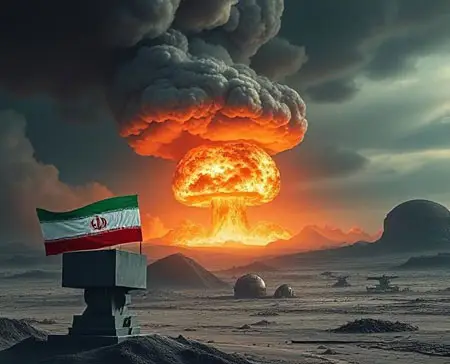(PCC)Israel’s dramatic airstrikes on Tehran remind the world that it is once again confronting one of the most alarming security questions of the 21st century: Was Iran on the verge of building a nuclear weapon, and how far might it still go?
Israel strikes hard, but is it enough to neutralize Iran’s nuclear development? The Israeli military operation that hit targets near Tehran on Friday the 13th wasn’t just a show of force; it was a signal. For years, Israel has insisted that Iran’s uranium enrichment program, now hovering at 60% purity, was a short technical step away from producing weapons-grade material. But this time, Israeli officials claim they had compelling evidence: Iran was assembling a primitive nuclear device, likely a “crude warhead,” in a secret facility.
According to Beni Sabti of the Institute of National Security Studies, the intelligence indicated not just potential, but intention. “They were pulling together the pieces, literally, in a covert location near Tehran,” he said.
Gregg Roman of the Middle East Forum added that Iranian reactivation of explosives-manufacturing lines resembled activities from their halted 2003 military nuclear program. “That’s not for peaceful purposes,” Roman warned.
Primitive warheads and dirty bombs make the next few days a human drama not just of death but of extinction. If Iran truly was racing toward a crude warhead, the immediate fear is an untested, rudimentary nuclear weapon, not a precision-engineered bomb like those in U.S. or Russian arsenals.
Such a device would likely be bulky, inefficient, and potentially unstable, but still capable of mass casualties and enormous political shock value.
Even more terrifying to some experts is the possibility of dirty bombs: conventional explosives laced with radioactive material. These don’t yield a nuclear explosion but can contaminate areas, cause panic, and disrupt economies, and they’re easier to make.
If Iran’s infrastructure or scientists have access to sufficient radioactive isotopes, possibly even imported or black-marketed, it could shift tactics toward such asymmetric, psychological weapons.
The Soviet question is filling the Pentagon in Washington, DC, and that is, could Iran have acquired “lost” nukes?
The long-standing mystery of missing Soviet nuclear weapons haunts every modern proliferation debate. After the Soviet Union’s collapse in 1991, thousands of warheads and massive stores of enriched uranium and plutonium were suddenly under weak security, spread across a crumbling empire.
Facts:
- Ukraine, Kazakhstan, and Belarus inherited parts of the Soviet nuclear arsenal but allegedly returned them by the mid-1990s. Yet no proof exists of any return nukes.
- The Nunn-Lugar program helped secure much of the arsenal, but not all.
- However, U.S. and allied intelligence agencies have never fully ruled out that nuclear devices, or enough fissile material to build them, has gone missing.
Rumors persist about “suitcase nukes,” small, portable warheads reportedly created by the Soviets. Russia denies they were ever lost, but American and European officials have never been fully convinced, and once again, Russia has never given a count of how many suitcase nukes they ever had or have now.
Could Iran, or a proxy actor, have acquired such material? No confirmed case of a stolen warhead has ever been made public. However, since the 1990s, the US have intercepted numerous smuggling attempts involving weapons-grade uranium or plutonium, mostly in Eastern Europe.
Israel and Iran teeter on the edge of possible nuclear war, even the faintest chance of “loose nukes” changing hands becomes intolerable for the world.
Trump’s 60-day ultimatum, along with the potential consequences that follow, creates a mind bender filled with ‘what ifs’ and unknowns.
President Donald Trump’s reentry into the diplomatic spotlight added another layer to Friday’s drama. On Truth Social, he claimed Friday marked “Day 61” of his 60-day ultimatum to Iran to agree to a new nuclear deal or face consequences.
But with bombs falling and negotiations now in limbo, any window for diplomacy appears to be slamming shut.
Political scientist Rosemary Kelanic warns that Israel may have acted not only on intelligence but also on ideology. “If you believe a nuclear Iran is existential, and you don’t trust negotiations, you don’t wait. You strike,” she said.
Kelanic further noted a paradox: Israel’s preemptive strike may have increased the very risk it hoped to avert. “Iran may now feel it has no choice but to pursue a crash program to build and test a device.”
Iran now stands at a crossroads. If its leadership views Israeli strikes as a declaration of war, they may choose to remove ambiguity and rush to build, or even test, a nuclear device. If they possess radioactive materials (or access through smuggling), dirty bombs could emerge as a near-term retaliatory option.
The chaos unleashed by Friday’s attack could either stop a nuclear Iran in its tracks or provoke it into becoming one. The world has seen this brinkmanship before, but never with stakes quite so high.
Final Word: Iran will be unable to redevelop a new nuclear program if the Persian people seize this moment and replace the totalitarian government with a constitutional republic.



